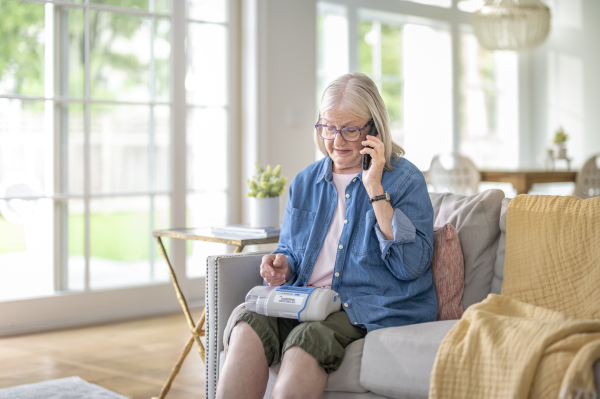Delayed Care During the COVID-19 Pandemic: Effects on Chronic Wound Therapy
November 30, 2021
Delayed Care During the COVID-19 Pandemic: Effects on Chronic Wound Therapy
Chronic wound care is challenging for the entire healthcare ecosystem, from clinicians to patients, and COVID-19 has only exacerbated those challenges. Patients are delaying primary care provider and wound clinician visits for ongoing guidance and therapy to reduce possible exposure to the virus. This is understandable, as many chronic wound patients are in the high-risk category if they become ill with COVID-19.1 They are also putting off elective surgeries, annual physicals, and basic preventive care, which can negatively affect long-term outcomes.
A survey of wound care clinicians in March 2021 reported a decrease in patient visits from pre-pandemic numbers, and 57% of respondents stated that "wound severity has either increased or significantly increased since the start of the pandemic."2 At the same time, the pandemic has accelerated patient-driven care and increased usage of interactive devices for care administered at home, rapidly increasing the use of telemedicine across demographics. In fact, one report by the research firm Frost & Sullivan says the demand for telemedicine services in the United States grew by over 60% in 2020 due to the pandemic.3
As the pandemic continues, it’s important to look at how reduced access to care might affect wound care in the future and how patient-driven and more value-based care options will come into play in daily practice.
The Trickledown Effect on Patient Outcomes and Their Wounds
While there have been improvements, access to care has not fully recovered, and continued COVID-19 surge rates suggest that delayed preventive and emergent wound care could continue to trend.4
This is a negative outcome from a public health perspective, which could prove catastrophic for wound patients as they leave themselves vulnerable to infection, sepsis, amputation, and possibly death. These problems are especially concerning in our growing senior population, whose chronic wounds are complicated by vascular disease, diabetes mellitus, and unrelieved pressure. A reduction of traditional weekly or biweekly wound care visits could increase hospitalization by a factor of 20 in the United States,5 exposing the scale and often unknown prevalence of chronic wounds and their impact on the healthcare system.  The increase in the rate of untreated wounds over the last year has led some researchers to describe the situation as a “pandemic within a pandemic.” A trauma center study in Ohio found that diabetic patients were “10.8 times more likely to undergo any level of amputation and 12.5 times more likely to undergo a major amputation during the COVID-19 pandemic.” Another study reported in the same AJMC article showed that “during COVID-19 lockdowns, patients with diabetes admitted to a tertiary care center for DFU had a more than threefold risk of amputation compared with those in 2019.”6
The increase in the rate of untreated wounds over the last year has led some researchers to describe the situation as a “pandemic within a pandemic.” A trauma center study in Ohio found that diabetic patients were “10.8 times more likely to undergo any level of amputation and 12.5 times more likely to undergo a major amputation during the COVID-19 pandemic.” Another study reported in the same AJMC article showed that “during COVID-19 lockdowns, patients with diabetes admitted to a tertiary care center for DFU had a more than threefold risk of amputation compared with those in 2019.”6
None of this is surprising, considering how delayed care has swept across the U.S. healthcare system, especially during the stage of rising Delta variant rates. And it’s impossible to imagine how neglected wound care rates could increase when a new variant emerges. COVID-19 has had a sustained, ongoing impact on how patients receive wound care. Or even if they will be able to receive care, because patients may remain uncomfortable visiting clinics as the pandemic lingers. Widespread staffing shortages are also a concern, and wound care treatment must adapt to meet patients where they are and where they feel comfortable receiving care.
Leading Through Patient-Centered Solutions
As the healthcare industry examines existing challenges, its leaders are finding new ways to transform outcomes. One notable shift is the acceleration of telemedicine. It is already a viable choice for healthcare professionals regarding preventive care like consultations, prescriptions, wellness checks, counseling, and more.
Access is an essential reason telehealth—or telemedicine—is playing such an important role. In 2019, more than half of U.S. households used the internet for health-related activities.7 And the pandemic has escalated this shift.8 During the first quarter of 2020, the number of telehealth visits increased by 50% compared with the same period in 2019.8 Another healthcare trend that is accelerating even more rapidly during the pandemic is a shift to value-based care. It aligns well with at-home therapy options enabled by remote monitoring and telemedicine because outcomes are easier to track.9 3M understands this, and was already introducing innovations in the virtual care space before COVID-19 with therapies to help manage patient’s wounds remotely, focusing on solving specific wound challenges in multiple care settings.
The advanced science and design of the 3M™ ActiV.A.C.™ Therapy Unit, for example, helps allow patients to resume daily activities at home while receiving the benefits of 3M™ V.A.C.® Therapy to help promote healing. The optional iOn Progress™ Remote Therapy Monitoring System provides supplemental service so that patients can receive remote one-on-one support from a Virtual Therapy Specialist. This helps the care team virtually support patients in their wound care journey, which has been shown to lead to more consistent patient use of therapy.10 Consistent monitoring and virtual check-ins from Virtual Therapy Specialists have been shown to help improve therapy adherence.11 And home-based care has demonstrated a reduction in hospital readmittance.12 This factor, combined with remote monitoring, may reduce costs for patients and insurers.13
Virtual Therapy Specialists can see very quickly if a patient’s alarm goes off or if they turn off the machine by accident or even on purpose. Patients can then receive a call providing the guidance they need to get back on track with their wound therapy. 3M is focused on applying evidence-based technologies to provide safe and effective healthcare solutions and will continue to drive the future of medicine by utilizing delivery tools and therapies that lead to more value-based care. This commitment to innovation led to acquiring Acelity, Inc. and its KCI subsidiaries in 2019—a business centered on advancing wound care and specialty surgical applications.
Through this integration, 3M has significantly expanded the ability to support customers along a patient’s surgical journey, hospital stay, or clinic visit. In addition to advanced wound care and skin management solutions, 3M now offers an expansive negative pressure wound therapy (NPWT) portfolio. Therapies like 3M™ ActiV.A.C.™ and the 3M™ Snap™ Therapy help enable patients to return to daily activities at home during healing, and can help make everyday living a little easier for wound patients, thanks to the proven benefits of NPWT. Read more about the ways 3M is transforming wound care at 3m.com/woundcare.
References
- Oropallo A. COVID-19: issues related to wound care and telehealth management. UpToDate. September 2021. Accessed October 27, 2021. https://www.uptodate.com/contents/covid-19-issues-related-to-wound-care…
- Armstrong DG. Managing the surge: delayed chronic wound care during COVID-19. AJMC. September 21, 2021. Accessed October 27, 2021. https://www.ajmc.com/view/managing-the-surge-delayed-chronic-wound-care…
- Frost & Sullivan. Telehealth to experience massive growth with COVID-19 pandemic, says Frost & Sullivan. May 13, 2020. Accessed October 27, 2021. https://www.frost.com/news/press-releases/telehealth-to-experience-mass…
- National Center for Healthcare Statistics. Reduced access to care: RANDS during COVID-19. CDC.gov. Updated August 6, 2021. Accessed October 27, 2021. https://www.cdc.gov/nchs/covid19/rands/reduced-access-to-care.htm
- Sen CK. Human wound and its burden: updated 2020 compendium of estimates. Adv Wound Care (New Rochelle). 2021;10(5):281-292. Accessed October 27, 2021. https://doi.org/10.1089/wound.2021.0026
- Armstrong DG. Managing the surge: delayed chronic wound care during COVID-19. AJMC. September 21, 2021. Accessed October 27, 2021. https://www.ajmc.com/view/managing-the-surge-delayed-chronic-wound-care…
- Johnson J. Internet usage in the United States: statistics & facts. Statista. August 4, 2021. Accessed October 27, 2021. https://www.statista.com/topics/2237/internet-usage-in-the-united-states
- Koonin LM, Hoots B, Tsang CA, et al. Trends in the use of telehealth during the emergence of the COVID-19 pandemic — United States, January–March 2020. MMWR Morb Mortal Wkly Rep. 2020;69:1595-1599. Accessed October 27, 2021. https://doi.org/10.15585/mmwr.mm6943a3
- Ruby J. The shift to value-based care has accelerated in the wake of the pandemic. MedCity News. April 2, 2021. Accessed October 27, 2021. https://medcitynews.com/2021/04/the-shift-to-value-based-care-has-accel…
- KCI. National iONPROGRESS Remote Therapy Monitoring Dashboard. Cutameen/RTM_Final_TD4_Tables. May 2010–April 2020.
- KCI. National iONPROGRESS Remote Therapy Monitoring Dashboard. Cutameen/RTM-Final_TD4_Tables. May 2010–April 2020.
- Howard J, Kent T, Stuck AR, et al. Improved cost and utilization among Medicare beneficiaries dispositioned from the ED to receive home health care compared with inpatient hospitalization. Am J Accountable Care. 2019;7(1):10-16.
- Griffin L. Comparison of ninety-day wound related costs for patients undergoing outpatient NPWT with or without remote therapy monitoring. Abstract presented at the Symposium on Advanced Wound Care 2020 Fall Meeting [virtual], November 4-6, 2020.
The views and opinions expressed in this blog are solely those of the author, and do not represent the views of WoundSource, HMP Global, its affiliates, or subsidiary companies.









Follow WoundSource
Tweets by WoundSource